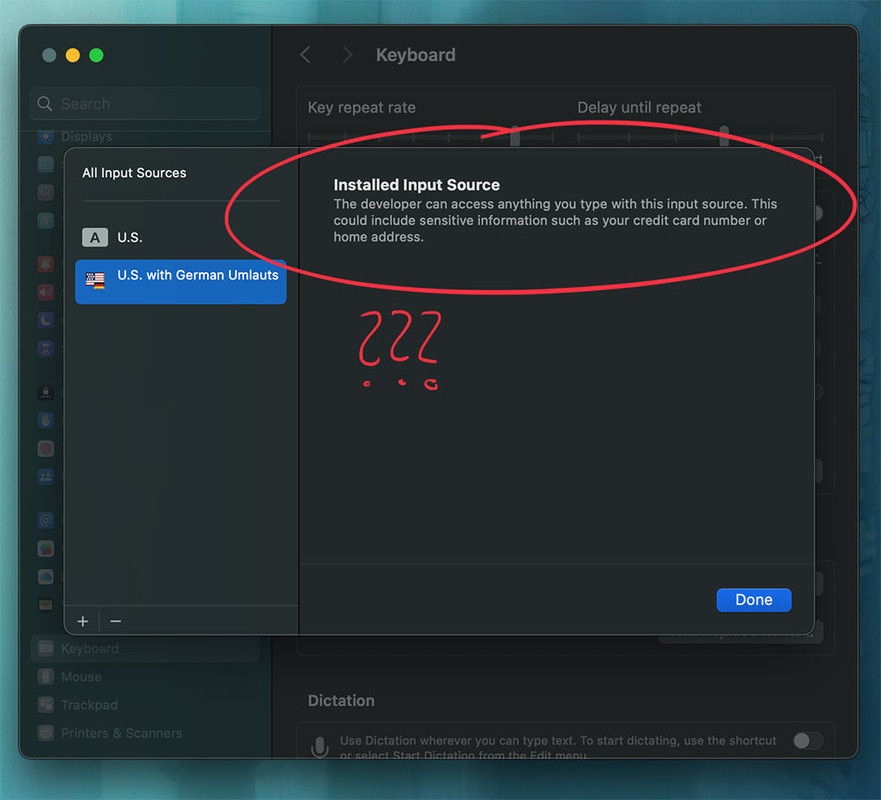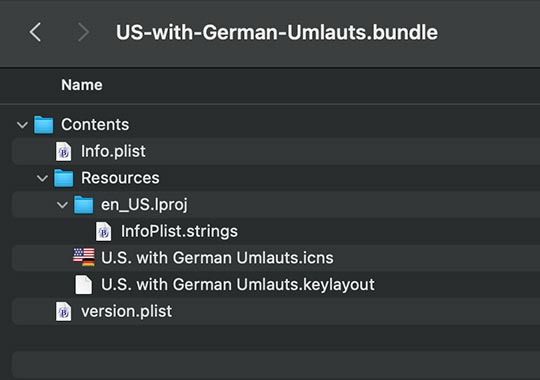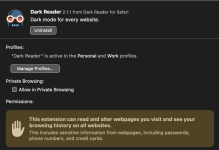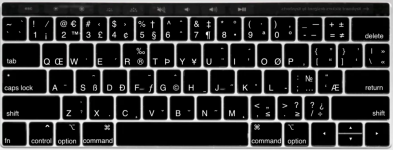Quick background: I frequently correspond in English as well as in German, and as such I need to be able to quickly access characters on my US keyboard that are usually available only on German keyboards: ä, ö, ü, Ä, Ö, Ü, ß, etc. For this purpose I always install a custom keyboard layout (*) that lets me access these characters with less fuss than Apple's standard US layout.
This has been my MO for ages – install macOS/boot new machine/whatever, do my customization thing (system utils, system prefs, etc.), install apps, copy over documents – and Bob's yer uncle, back to work I get.
Today however, while doing my usual customization thing, I got stuck at a stern and (to me) new, and rather weird warning "System Settings.app" flashed at me. Following the install of my custom keyboard layout, in the attempt to select this layout as my default, "System Settings.app" tells me:

Somewhat alarmed by this dire warning, I head on over to "/Library/Keyboard Layouts/" to take a closer look at the contents of the *.bundle file I'd just installed. Therein lie the following files...

The bundle contains no executables or scripts of any kind (.app/.sh/*.py/whatever), there are no weird permissions to any of the files, no invisible files – only four XML files of various flavors (plist/strings/keylayout), none of which as much as mention any domains, IP addresses, whatever they might want to contact, and a single *.icns icon/image file.
Now I sit here, scratching my head over how this particular a keyboard layout file, or rather bundle, could possibly either collect any information I am typing, let alone contact a remote server to transmit such surreptitiously collected data?
What am I missing? Am I just an utter clot who needs to hand in his macOS license, am I losing my mind, or did Tim Cook (**) go off the deep end?
I am genuinely at a bit of a loss here... any ideas from the hive mind?
(* – custom keyboard layouts/input sources having been around for ages in macOS, created for example with simple utilities like Ukulele, etc.)
(** – using him as a metaphorical stand-in for Apple Inc.)
This has been my MO for ages – install macOS/boot new machine/whatever, do my customization thing (system utils, system prefs, etc.), install apps, copy over documents – and Bob's yer uncle, back to work I get.
Today however, while doing my usual customization thing, I got stuck at a stern and (to me) new, and rather weird warning "System Settings.app" flashed at me. Following the install of my custom keyboard layout, in the attempt to select this layout as my default, "System Settings.app" tells me:
macOS' System Settings.app said:Installed Input Source - The developer can access anything you type with this input source. This could include sensitive information such as your credit card number or home address.

Somewhat alarmed by this dire warning, I head on over to "/Library/Keyboard Layouts/" to take a closer look at the contents of the *.bundle file I'd just installed. Therein lie the following files...

The bundle contains no executables or scripts of any kind (.app/.sh/*.py/whatever), there are no weird permissions to any of the files, no invisible files – only four XML files of various flavors (plist/strings/keylayout), none of which as much as mention any domains, IP addresses, whatever they might want to contact, and a single *.icns icon/image file.
Now I sit here, scratching my head over how this particular a keyboard layout file, or rather bundle, could possibly either collect any information I am typing, let alone contact a remote server to transmit such surreptitiously collected data?
What am I missing? Am I just an utter clot who needs to hand in his macOS license, am I losing my mind, or did Tim Cook (**) go off the deep end?
I am genuinely at a bit of a loss here... any ideas from the hive mind?
(* – custom keyboard layouts/input sources having been around for ages in macOS, created for example with simple utilities like Ukulele, etc.)
(** – using him as a metaphorical stand-in for Apple Inc.)






